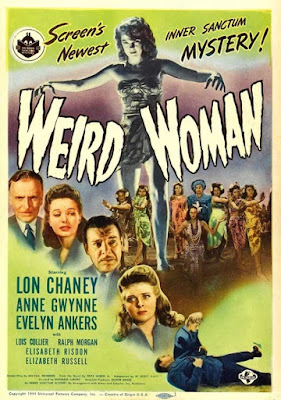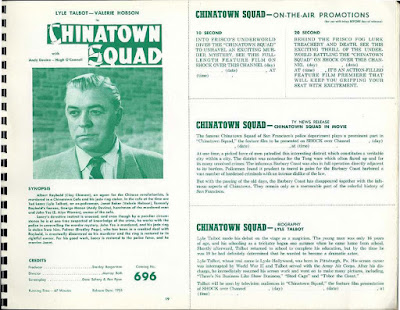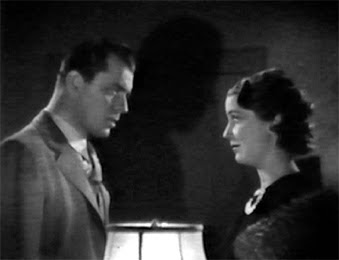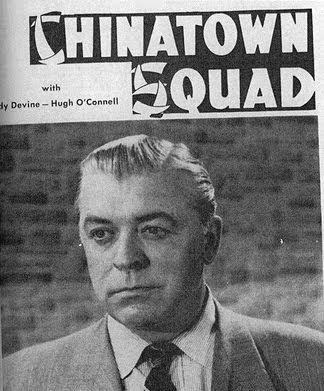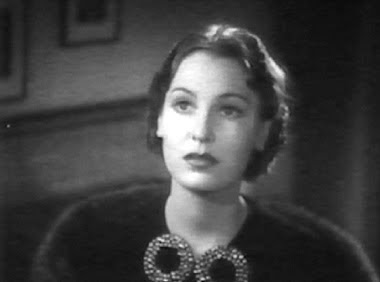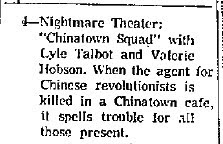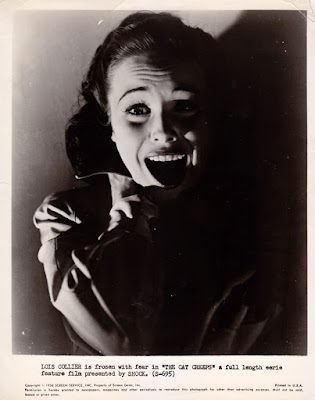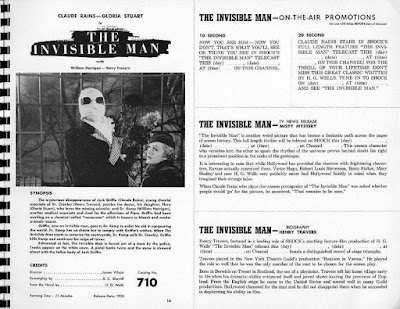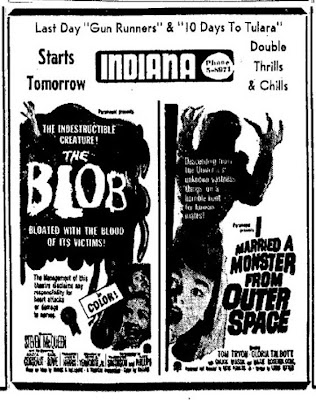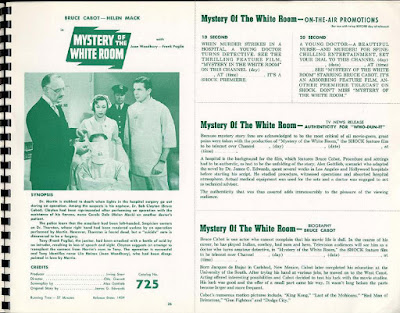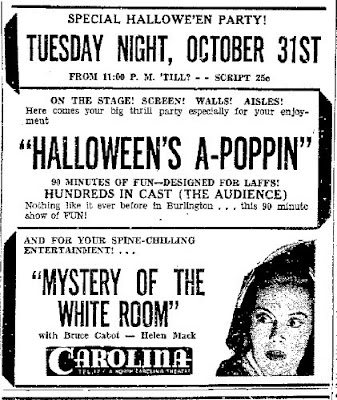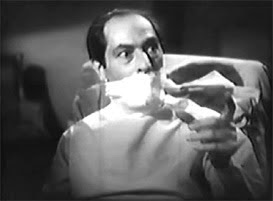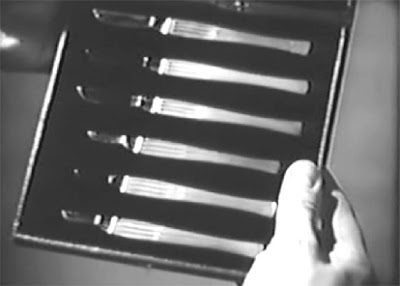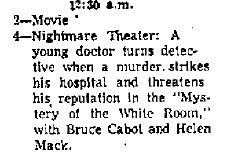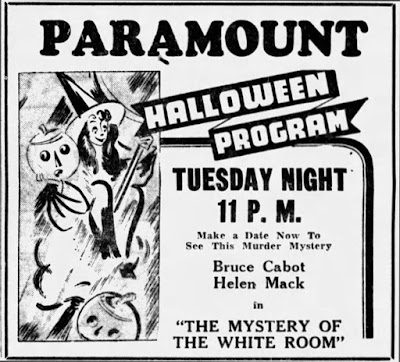THE CREEPING BRIDE: Monroe
College sociology professor Norman Reed (Lon Chaney, Jr.) is jinxed. A
"mental giant" and a rising star, Reed has just returned from a jaunt
somewhere in the tropical isles of the South Seas; he has brought back
with him new research for a groundbreaking study on religion called Superstition vs. Science and Fact
and a new wife, a lovely woman-child native priestess named Paula
(Anne Gwynne). He seemed to be on the fast-track to becoming department
chair, but that's when things spiraled out of control: his colleague
Professor Millard Sawtelle (Ralph Morgan) shot himself to avoid a
possible plagiarism scandal; Sawtelle's Lady Macbethian wife Evelyn
(Elizabeth Russell) accuses Reed and his "witch" of engineering the
scandal; and nasty rumors that Reed "has taken advantage of" his pretty
undergraduate research assistant (Lois Collier, who may have been
recognized by some SHOCK! viewers for her recurring appearances between
1951 and 1953 on Ziv's "Boston Blackie" TV show) dog him all over
campus-- in fact, Reed is said to have beaten up his assistant's
boyfriend when the latter tried to defend her honor. Then, while Paula
continues to be the target of terrorizing harassment by Reed's bitter
ex-lover Ilona (Evelyn Ankers), there is shooting on campus and the
blame falls on Reed.
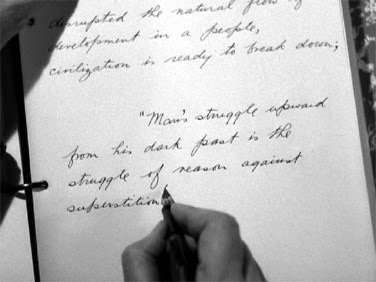
 Ad for KUTV-Channel 2's "Shock Theater" with horror-host Roderick in Salt Lake [UT] Tribune, February 27, 1960. COUNTER-ESPIONAGE (1942) was one of the "Lone Wolf" mystery-thrillers
Ad for KUTV-Channel 2's "Shock Theater" with horror-host Roderick in Salt Lake [UT] Tribune, February 27, 1960. COUNTER-ESPIONAGE (1942) was one of the "Lone Wolf" mystery-thrillers
As I've said previously when I've written about the Inner Sanctum series
in the SHOCK! collection, these were popular with audiences when they
were first released and when theatrically re-released (WEIRD WOMAN made
the rounds again starting in 1952). I've also seen a few of them turn up
as special midnight spook shows, so Screen Gems' inclusion of these
titles in SHOCK! was probably viewed as a selling point for the package.
 San Antonio [TX] Light, June 6, 1957. What
a Universal horror drive-in line-up! WEIRD WOMAN (the typo that
pluralizes the title is actually more accurate considering what happens
in the movie) is shown here on Monday night with NIGHT MONSTER.
San Antonio [TX] Light, June 6, 1957. What
a Universal horror drive-in line-up! WEIRD WOMAN (the typo that
pluralizes the title is actually more accurate considering what happens
in the movie) is shown here on Monday night with NIGHT MONSTER.
Many
fans seem to like WEIRD WOMAN best; I prefer it because there is at
least a not-easily-explained-away supernatural thread that runs through
this picture that you don't find in the other five films of the series.
But I also like it because of the almost campy level of neurotic
hysteria that energizes everything here, particularly Paula, Ilona, and
Evelyn (when all is said and done, who is the titular weird woman,
anyway?).
 Ordinarily,
watching WEIRD WOMAN elicits a few harsh hoots of derisive laughter
from me, but I made a very conscientious effort to watch it in good
faith this time for the SHOCK! Viewing Project. Lon Chaney, Jr. still
seems miscast as the brilliant and desirable intellectual, and his
acting cannot keep up with the work done here by Gwynne, Ankers, and
Russell, but I wanted to avoid thinking about that and just try to focus
on the persistence of supernatural elements in an effort to recreate
the horror-movie-on-TV experience as best as I could. And I feel that I
largely succeeded-- I think that I could see WEIRD WOMAN's horror movie
appeal for the first time.
Ordinarily,
watching WEIRD WOMAN elicits a few harsh hoots of derisive laughter
from me, but I made a very conscientious effort to watch it in good
faith this time for the SHOCK! Viewing Project. Lon Chaney, Jr. still
seems miscast as the brilliant and desirable intellectual, and his
acting cannot keep up with the work done here by Gwynne, Ankers, and
Russell, but I wanted to avoid thinking about that and just try to focus
on the persistence of supernatural elements in an effort to recreate
the horror-movie-on-TV experience as best as I could. And I feel that I
largely succeeded-- I think that I could see WEIRD WOMAN's horror movie
appeal for the first time.
 Ordinarily,
watching WEIRD WOMAN elicits a few harsh hoots of derisive laughter
from me, but I made a very conscientious effort to watch it in good
faith this time for the SHOCK! Viewing Project. Lon Chaney, Jr. still
seems miscast as the brilliant and desirable intellectual, and his
acting cannot keep up with the work done here by Gwynne, Ankers, and
Russell, but I wanted to avoid thinking about that and just try to focus
on the persistence of supernatural elements in an effort to recreate
the horror-movie-on-TV experience as best as I could. And I feel that I
largely succeeded-- I think that I could see WEIRD WOMAN's horror movie
appeal for the first time.
Ordinarily,
watching WEIRD WOMAN elicits a few harsh hoots of derisive laughter
from me, but I made a very conscientious effort to watch it in good
faith this time for the SHOCK! Viewing Project. Lon Chaney, Jr. still
seems miscast as the brilliant and desirable intellectual, and his
acting cannot keep up with the work done here by Gwynne, Ankers, and
Russell, but I wanted to avoid thinking about that and just try to focus
on the persistence of supernatural elements in an effort to recreate
the horror-movie-on-TV experience as best as I could. And I feel that I
largely succeeded-- I think that I could see WEIRD WOMAN's horror movie
appeal for the first time.
 A big stumbling block for me, though, was the handling of the dance and prayer ceremony on Paula's island. In Drums o' Terror: Voodoo in the Cinema (1998),
Bryan Senn describes this more as "a genteel luau" than a "frenzied
rite": "Though Paula ominously labels it the 'Dance of Death,'
sarong-wearing native girls pathetically stomp their feet and clap and
wave their hands in an innocuously choreographed motion, making this
weird pagan ritual look like low-rent nightclub filler." I have to
wonder if the ceremony could have had a more disturbing edge in the
hands of a director other than Reginald LeBorg (John Fulton's shooting
star that crosses the sky at the climax of the Dance of Death looked
good, though).
A big stumbling block for me, though, was the handling of the dance and prayer ceremony on Paula's island. In Drums o' Terror: Voodoo in the Cinema (1998),
Bryan Senn describes this more as "a genteel luau" than a "frenzied
rite": "Though Paula ominously labels it the 'Dance of Death,'
sarong-wearing native girls pathetically stomp their feet and clap and
wave their hands in an innocuously choreographed motion, making this
weird pagan ritual look like low-rent nightclub filler." I have to
wonder if the ceremony could have had a more disturbing edge in the
hands of a director other than Reginald LeBorg (John Fulton's shooting
star that crosses the sky at the climax of the Dance of Death looked
good, though).
I enjoy seeing some of the names that television stations used for their late-night
movies-on-TV showcases. "Operation: Swing Shift" on WGR-Channel 2 in
Buffalo, NY is one of the most unusual names. "Operation: Swing Shift"
featured a variety of film genres in their offerings and very few of
them seemed to have been horror films.
* * *
Trailer:





